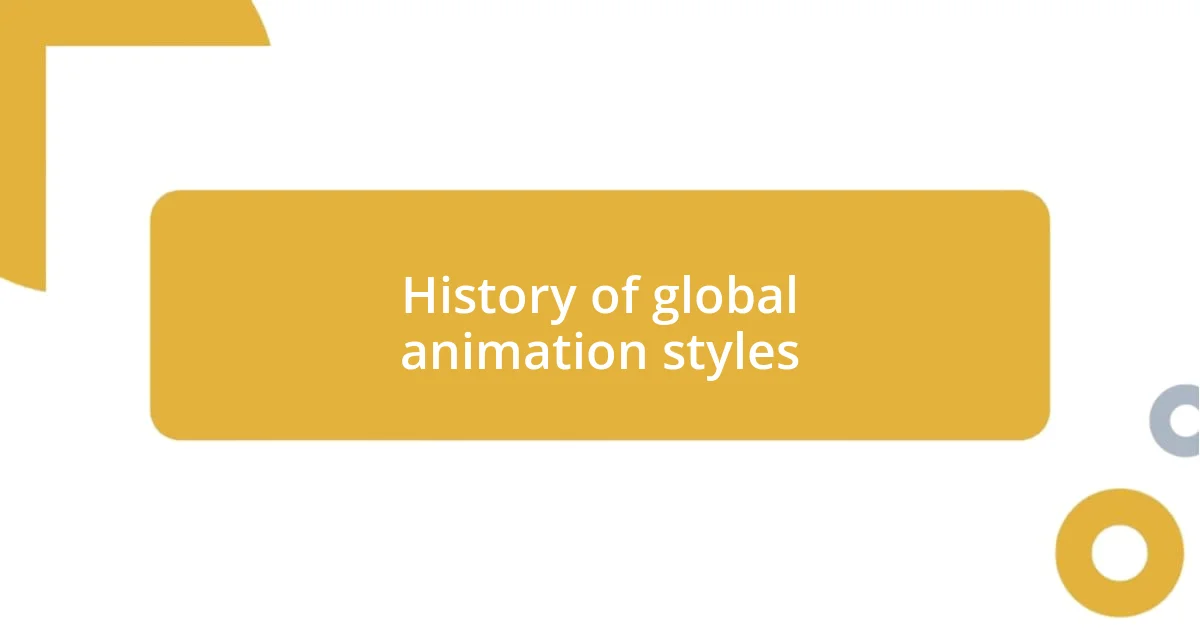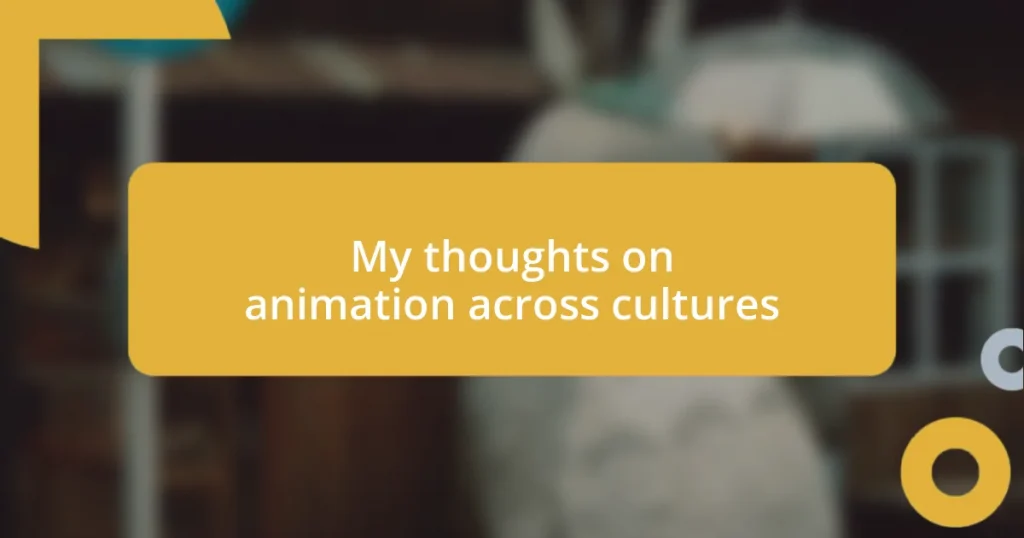Key takeaways:
- Animation serves as a powerful medium for cultural exchange, reflecting diverse traditions while connecting emotionally with audiences worldwide.
- The evolution of animation techniques across cultures demonstrates unique storytelling methods, from traditional hand-drawn styles to modern digital animation, each conveying cultural nuances.
- The future of cross-cultural animation lies in blending styles, addressing social issues, and leveraging digital platforms for broader accessibility and cultural dialogue.

Understanding animation’s cultural impact
Animation is a powerful medium that reflects and shapes cultural narratives. I vividly remember watching Studio Ghibli films as a kid, mesmerized by the lush landscapes and deep-rooted Japanese folklore. Have you ever noticed how these enchanting stories resonate on a profoundly emotional level, bridging cultural gaps while still showcasing unique traditions?
Through animation, we experience diverse perspectives that challenge our own views. I think back to the day I first saw “Coco,” a film celebrating Mexican culture and the significance of family and remembrance. It beautifully encapsulated the vibrant traditions of Día de los Muertos, eliciting tears of joy and nostalgia. Isn’t it fascinating how animation can transform cultural celebration into a universal experience?
Moreover, animation often serves as a reflection of societal issues and shifts within a culture. When I saw “Zootopia,” it struck me how cleverly it tackled themes of prejudice and acceptance, all within a colorful, engaging story. Doesn’t animation have a unique ability to spark important conversations in an approachable way, encouraging viewers to reflect on their own culture and its complexities?

History of global animation styles
When I delve into the history of global animation styles, it amazes me how diverse and rich the landscape is. Each culture brings forth unique techniques and narratives that reflect their stories and traditions. Early animation can be traced back to the silent film era, with figures like Winsor McCay leading the way. As the medium evolved, different regions developed their own styles, giving rise to distinct aesthetics that still influence animators today.
- Early Innovations: McCay’s “Gertie the Dinosaur” in 1914 showcased character animation.
- American Mainstream: The golden age of animation in the 1930s introduced iconic characters and feature films like Disney’s “Snow White.”
- Japanese Pioneers: In the 1960s, Osamu Tezuka revolutionized anime, creating styles that resonate globally, influencing both storytelling and visual presentation.
- European Expression: Countries like France and the Netherlands embraced experimental animation, focusing on artistic narratives rather than commercial appeal.
- Digital Revolution: The late 20th century saw the rise of computer animation, with Pixar leading the charge, blending technology with heartfelt narratives.
I fondly recall discovering European animation through films like “The Triplets of Belleville.” The quirky, whimsical style was a stark contrast to what I had seen from Hollywood. It opened my eyes to the fact that animation isn’t just for children; it can tackle intricate themes and adult humor creatively. Isn’t it incredible how a simple animated frame can convey so much cultural depth?

Comparison of animation techniques worldwide
Exploring animation techniques across cultures reveals a fascinating blend of artistry and storytelling. I remember watching the mesmerizing, fluid animation of traditional Chinese brush painting in films like “Spiritstice,” which felt like watching a painting come to life. This technique, steeped in history, contrasts sharply with the crisp, digital animation styles I’ve seen in contemporary Western productions, where everything feels precise and polished. Have you noticed how these differences not only reflect cultural nuances but also convey emotional weight in unique ways?
In Japan, anime showcases an incredible range of styles, from the detailed character designs of “Attack on Titan” to the minimalist approach in “Kiki’s Delivery Service.” My first anime experience was with “My Neighbor Totoro,” and I was captivated by how the animations seemed to evoke feelings that resonated deeply, even without extensive dialogue. This emphasis on expressive character design allows for a profound connection between the viewer and the narrative, showcasing the power of animation to transcend language barriers.
Meanwhile, stop-motion animation brings its own charm, as evidenced by films like “Coraline” or “The Isle of Dogs.” I still recall the time I learned about the painstaking process behind it, knowing that each movement required a meticulous touch. The tactile quality of stop-motion can evoke a sense of nostalgia and warmth, reminding viewers of handcrafted artistry. Don’t you think it’s magical how diverse techniques can transform stories into such varied experiences?
| Region | Technique |
|---|---|
| East Asia | Anime (e.g., Studio Ghibli) |
| North America | Digital 2D and 3D Animation (e.g., Disney, Pixar) |
| Europe | Stop-motion and Experimental Animation (e.g., Aardman Animations) |
| Middle East | Traditional and Modern Hand-drawn Techniques (e.g., “The Breadwinner”) |
| Africa | Paper cut-out and Stop-motion (e.g., “The Lion’s Mouth”) |

Case studies of cultural animations
Exploring case studies of cultural animations reveals how deeply animation can resonate with audiences. I remember watching the South African film “Khumba,” where the story of a zebra’s quest for acceptance took me on an emotional journey while showcasing the vibrant landscapes of Africa. The film’s unique blend of humor and poignant themes made me appreciate the cultural heritage represented in the story. Isn’t it fascinating how narratives rooted in one culture can touch hearts around the globe?
Additionally, as I journeyed through Latin American animations, “Coco” stood out to me. It did more than just entertain; it embraced the significance of family and remembrance in Mexican culture. The rich colors, lively music, and homage to the Day of the Dead festivities felt like a celebration. Watching it felt like stepping into a family reunion where every frame rejoiced in tradition and heritage. How can a film convey such warmth and cultural pride in just under two hours?
Lastly, I’ve also explored the unique storytelling methods in Indian animation, particularly with films like “Ghanashyam,” which merges mythology with contemporary themes. The fluid animation techniques and vibrant color palettes pulled me into a world where ancient tales meet modern dilemmas. It raises an intriguing question: can animation be a bridge between centuries-old traditions and contemporary issues? I believe it absolutely can, showcasing the transformative power of animation to convey diverse cultural narratives.

Future trends in cross-cultural animation
When I think about the future of cross-cultural animation, it’s exciting to see how blending different styles can create something entirely new. For instance, I recently watched a short film that mixed traditional African cut-out techniques with a modern narrative, and it blew me away. The result was a vibrant tapestry that felt both familiar and innovative. Have you ever experienced animation that seamlessly fuses elements from various cultures, making you appreciate diversity in storytelling?
Moreover, the rise of digital platforms has significantly impacted how animations cross borders. I remember being captivated by a web series that showcased stories from various regions, allowing characters from different backgrounds to interact and share their experiences. This not only promotes cultural exchange but also gives budding animators the chance to present their unique perspectives on a global stage. It makes me wonder—how will this evolution in accessibility influence the next generation of storytellers?
Additionally, I foresee a greater emphasis on social issues within cross-cultural animations. For example, I’ve been seeing more animated films tackle themes like climate change through varied cultural lenses, blending humor and gravity to reach different audiences. This blend not only entertains but educates viewers, prompting them to think about pressing global concerns. With such potent storytelling potential, don’t you think animation can be a powerful tool for sparking meaningful conversations across cultures?















